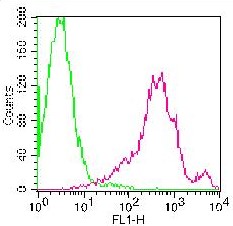Polyclonal Antibody to RDC1

Fig-1: Western blot analysis RDC1. Anti-RDC1 antibody (11-8009) was used at 0.5 µg/ml on HL-60 lysate.
Roll over image to zoom in
Shipping Info:
Order now and get it on Thursday April 24, 2025
Same day delivery FREE on San Diego area orders placed by 1.00 PM
| Format : | Purified |
| Amount : | 100 µg |
| Isotype : | Rabbit IgG |
| Purification : | Protein A Chromatography |
| Content : | 25 µg in 50 µl/100 µg in 200 µl PBS containing 0.05% BSA and 0.05% sodium azide. Sodium azide is highly toxic. |
| Storage condition : | Store the antibody at 4°C; stable for 6 months. For long-term storage; store at -20°C. Avoid repeated freeze and thaw cycles. |
RDC1 is a chemokine receptor that belongs to the membrane-bound G protein-coupled receptor superfamily. It is frequently and specifically expressed in tumor-associated vessels. It controls cell proliferation and migration during development, tumorigenesis, and inflammatory processes. It represents an atypical or scavenger chemokine receptor which modulates the function of CXCR4. RDC1 is involved in the EMT (Epithelial-mesenchymal transition) process of epithelial ovarian carcinomas.
Western blot analysis: 0.5-1 µg/ml
For Research Use Only. Not for use in diagnostic/therapeutics procedures.
| Subcellular location: | Cell membrane, Cytoplasm, Early endosome, Recycling endosome |
| Post transnational modification: | Ubiquitinated at the Lys residues in its C-terminal cytoplasmic tail and is essential for correct trafficking from and to the cell membrane. Deubiquitinated by CXCL12-stimulation in a reversible manner. |
| Tissue Specificity: | Expressed in monocytes, basophils, B-cells, umbilical vein endothelial cells (HUVEC) and B-lymphoblastoid cells. Lower expression detected in CD4+ T-lymphocytes and natural killer cells. In the brain, detected in endothelial cells and capillaries, and in mature neurons of the frontal cortex and hippocampus. Expressed in tubular formation in the kidney. Highly expressed in astroglial tumor endothelial, microglial and glioma cells. Expressed at low levels in normal CD34+ progenitor cells, but at very high levels in several myeloid malignant cell lines. Expressed in breast carcinomas but not in normal breast tissue (at protein level). |
| BioGrid: | 121321. 11 interactions. |
|
There are currently no product reviews
|




















.png)












